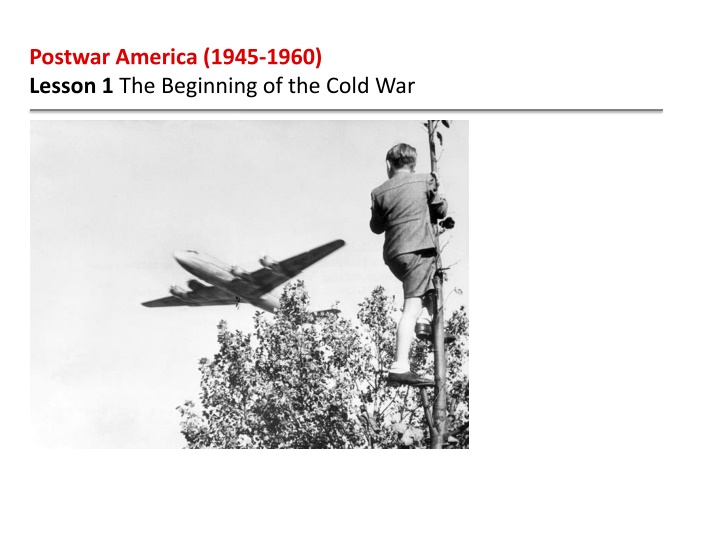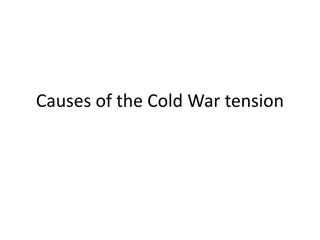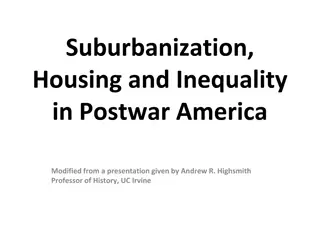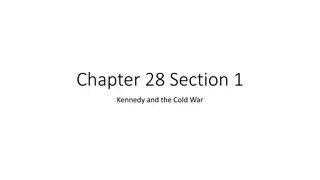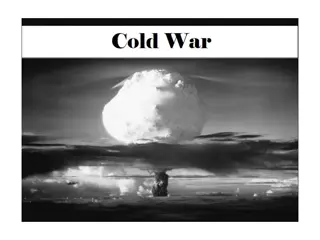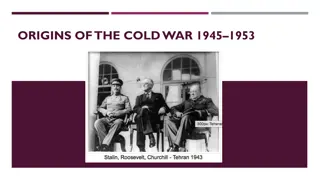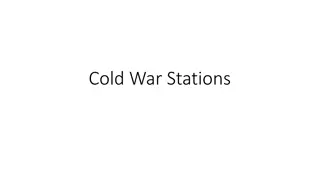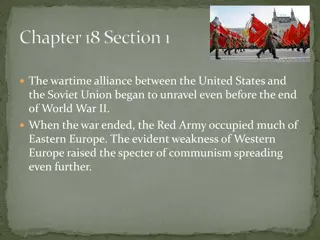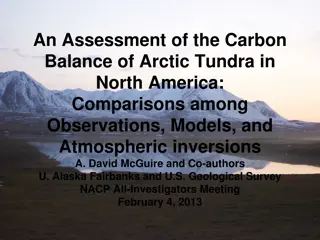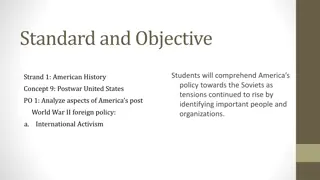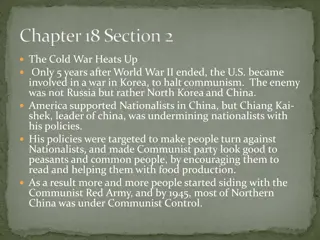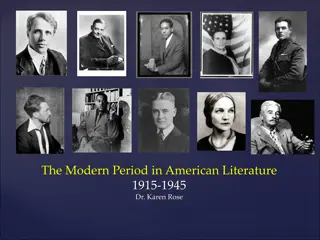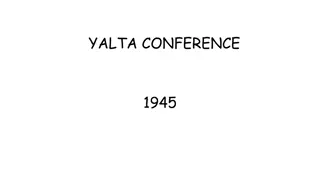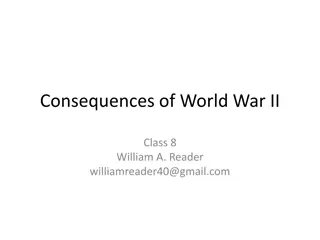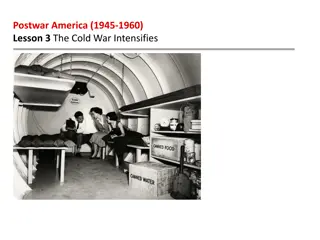The Beginning of the Cold War: Postwar America (1945-1960) Lesson 1
Postwar America (1945-1960) Lesson 1 explores the unraveling of the wartime alliance between the United States and the Soviet Union, President Truman's response to Soviet aggression in Eastern Europe, and the causes and results of Stalin's blockade of Berlin. The background of the Cold War, Soviet aggression, the division of Europe, and responses to the Soviet challenge are discussed with key terms highlighted.
Download Presentation

Please find below an Image/Link to download the presentation.
The content on the website is provided AS IS for your information and personal use only. It may not be sold, licensed, or shared on other websites without obtaining consent from the author.If you encounter any issues during the download, it is possible that the publisher has removed the file from their server.
You are allowed to download the files provided on this website for personal or commercial use, subject to the condition that they are used lawfully. All files are the property of their respective owners.
The content on the website is provided AS IS for your information and personal use only. It may not be sold, licensed, or shared on other websites without obtaining consent from the author.
E N D
Presentation Transcript
Postwar America (1945-1960) Lesson 1 The Beginning of the Cold War
Postwar America (1945-1960) Lesson 1 The Beginning of the Cold War Learning Objectives Trace the reasons that the wartime alliance between the United States and the Soviet Union unraveled. Explain how President Truman responded to Soviet aggression in Eastern Europe. Describe the causes and results of Stalin s blockade of Berlin.
Postwar America (1945-1960) Lesson 1 The Beginning of the Cold War Key Terms satellite states Cold War iron curtain Truman Doctrine George F. Kennan containment Marshall Plan Berlin airlift North Atlantic Treaty Organization (NATO) Warsaw Pact
Background of the Cold War In the 1930s, the policies of isolationism and appeasement did nothing to stop the rise of dictatorships and the outbreak of global war. After World War II, U.S. leaders viewed these past policies as mistakes. They sought new ways to keep the United States safe as well as to protect its interests around the world.
Background of the Cold War Soviet Aggression Against Its Citizens Soviets Control Eastern Europe Wartime Alliance Unravels
Background of the Cold War Russian soldier raising the Soviet flag over Berlin, Germany, in April, 1945.
Background of the Cold War Analyze Maps As the Cold War developed after World War II, Europe became divided. Based on the map, why would the Soviet Union have benefited from gaining control of Greece and Turkey?
Responding to the Soviet Challenge President Truman was not the only world leader who believed that Stalin had aspirations toward world domination. Winston Churchill also spoke out forcefully against the Soviet Union. On March 5, 1946, he gave an important speech at Fulton College in Missouri, Truman s home state. Referring to a map of Europe, Churchill noted that an iron curtain has descended across the Continent.
Responding to the Soviet Challenge Truman Faces Soviet Aggression in Eastern Europe The Truman Doctrine Opposes Soviet Aggression
Responding to the Soviet Challenge Winston Churchill delivers his Iron Curtain speech. This descriptive phrase became a lasting symbol of the brutal division that communism had created in Western Europe.
The United States Contains Soviet Expansion In the July 1947 issue of the magazine Foreign Affairs, a writer who called himself X published an article titled The Sources of Soviet Conduct. The author was really George F. Kennan, an American diplomat and a leading authority on the Soviet Union. His article presented a blueprint for the American policy that became known as containment because its goal was to keep communism contained within its existing borders.
The United States Contains Soviet Expansion Kennan Urges a Policy of Containment United States Responds with Marshall Plan
The United States Contains Soviet Expansion George Kennan, an expert on Russian history and culture, was the driving force behind American policy toward the Soviet Union in the early years of the Cold War.
The United States Contains Soviet Expansion Analyze Graphs This graph shows the shipments financed by the Marshall Plan. Based on the chart, why would Food and Other Produce take up such a large percentage of the shipments?
Soviet Aggression Drives Cold War The front lines of the Cold War were located in Germany. The zones that were controlled by France, Britain, and the United States were combined to form West Germany. West Germany was bordered on the east by the Soviet-controlled East Germany. The Allies also controlled the western part of Berlin, a city tucked deep inside communist East Germany.
Soviet Aggression Drives Cold War United States and Britain Respond with Berlin Airlift The North Atlantic Treaty Organization
Soviet Aggression Drives Cold War The United States and Great Britain supplied goods to West Berlin by plane during the Berlin Airlift.
Soviet Aggression Drives Cold War Analyze Tables Which NATO countries were not located in Europe?
Quiz: Background of the Cold War What happened in many Eastern European countries after World War II? A. They were occupied by the United States military. B. They became satellite states controlled by the Soviet Union. C. They joined the alliance that opposed communist expansion. D. They received aid through the Marshall Plan to help their economies.
Quiz: Responding to the Soviet Challenge What did Winston Churchill describe as an iron curtain? A. the movement of military forces during World War II B. the political impact of communism in the United States C. the threat of a communist takeover in Greece and Turkey D. the border between Western Europe and Eastern Europe
Quiz: The United States Contains Soviet Expansion The Marshall Plan succeeded in providing A. military aid to Eastern Europe. B. economic aid to Western Europe. C. increased political stability in the United States. D. support for the struggling nations of Eastern Europe.
Quiz: Soviet Aggression Drives Cold War Stalin s attempt to blockade Berlin failed largely as a result of A. the Berlin airlift. B. the Marshall Plan. C. collective security. D. inadequate resources.
